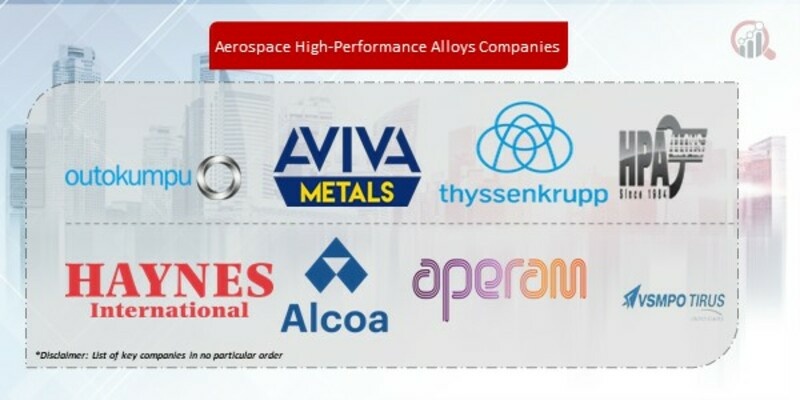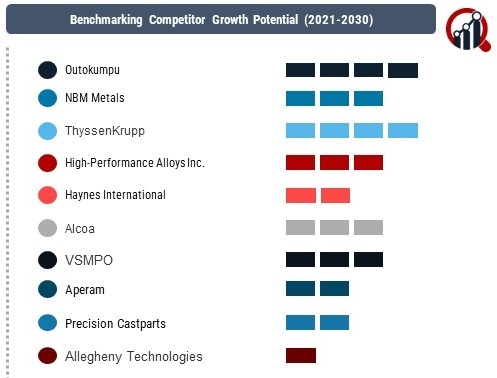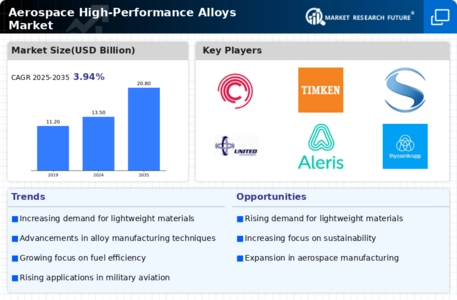Top Industry Leaders in the Aerospace High Performance Alloys Market

Key Players
Outokumpu (Finland)
NBM Metals (US)
ThyssenKrupp (Germany)
High-Performance Alloys Inc. (US)
Haynes International (US)
Alcoa (US)
VSMPO (US)
Aperam (Germany)
Precision Castparts (US)
Allegheny Technologies (US)
Carpenter Technology (US)
Strategies Adopted by Key Players:
The strategies adopted by key players in the aerospace high-performance alloys market are multifaceted and tailored to meet the evolving needs of the aerospace industry. Vertical integration is a common approach, where companies control the entire supply chain from raw materials to the production of finished alloys. This strategy enhances cost efficiency and ensures a seamless flow of materials, enabling companies to maintain a competitive edge. Additionally, a focus on product innovation and the development of alloys with enhanced strength-to-weight ratios remains a key strategy. Collaborations with aircraft manufacturers and stringent quality control measures further strengthen the market position of these key players.
Market Share Analysis Factors:
Several factors contribute to the market share analysis within the aerospace high-performance alloys market. Quality and performance specifications are paramount, as aerospace applications demand materials that can withstand extreme conditions while minimizing weight. Key players invest significantly in research and development to introduce alloys that meet or exceed industry standards. Regulatory compliance is another crucial factor, as certifications from aviation authorities are essential for market acceptance. Furthermore, the ability to provide a diverse portfolio of alloys for different aerospace components, such as engines, airframes, and landing gear, significantly influences market share.
New and Emerging Companies:
The aerospace high-performance alloys market is witnessing the emergence of new players eager to capitalize on the growing demand for advanced materials in the aerospace sector. Companies like VSMPO-AVISMA Corporation and Haynes International are gaining traction with their specialized alloys catering to specific aerospace applications. These emerging companies often bring fresh perspectives and innovative solutions, challenging established players. As they focus on niche markets or develop alloys with unique properties, they carve a niche for themselves in the competitive landscape.
Industry News and Innovations:
The aerospace high-performance alloys market is marked by a continuous stream of industry news and innovations. Advancements in metallurgy, alloy design, and manufacturing processes are regularly announced, driving the evolution of materials used in aerospace applications. For instance, breakthroughs in additive manufacturing techniques have opened new possibilities for alloy design and customization. Industry players are increasingly investing in 3D printing technologies to create complex components with improved performance characteristics. Such innovations not only cater to current market needs but also shape future trends within the aerospace high-performance alloys sector.
Current Company Investment Trends:
Investment trends in the aerospace high-performance alloys market reflect the industry's commitment to staying at the forefront of technological advancements. Companies are allocating substantial resources to research and development, aiming to create alloys with superior mechanical properties, corrosion resistance, and temperature stability. Moreover, investments in sustainable and eco-friendly alloys are on the rise, aligning with the aviation industry's growing focus on environmental responsibility. Strategic acquisitions and partnerships are also prevalent, allowing companies to expand their product portfolios and enhance their overall market position.
Overall Competitive Scenario:
The overall competitive scenario in the aerospace high-performance alloys market is characterized by intense rivalry, innovation-driven competition, and a constant quest for technological superiority. Established players continue to invest in maintaining their market dominance through vertical integration, product diversification, and global expansion. Meanwhile, new entrants and emerging companies challenge the status quo by introducing specialized alloys and disruptive technologies.
The market's future trajectory will likely be influenced by factors such as geopolitical dynamics, global economic trends, and the aerospace industry's evolution. As the demand for fuel-efficient aircraft, space exploration, and military applications continues to rise, the aerospace high-performance alloys market will remain a focal point for technological innovation and strategic competition. Companies that can adapt to changing industry requirements, foster innovation, and navigate regulatory landscapes will be well-positioned to thrive in this dynamic and competitive market.
Latest News
Several key players dominate the aerospace high-performance alloys market. Companies such as ATI, Alcoa Corporation, and Arconic have a longstanding presence and are renowned for their innovative solutions. These industry giants leverage their extensive experience and research capabilities to offer alloys that meet the stringent requirements of aerospace applications. Additionally, Carpenter Technology Corporation and Aperam are notable players, contributing significantly to the market's competitiveness. The continuous emphasis on research and development, coupled with strategic partnerships, enables these companies to maintain their dominance in the market.











